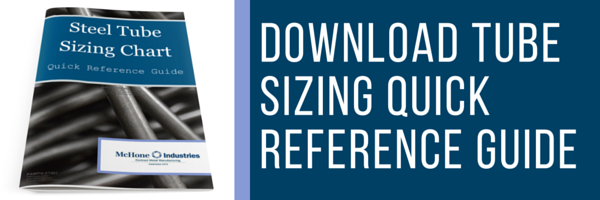
Not all tubular steel products are the same.
Though that might seem like a given, the two major product categories for tubular steel leaves some room for confusion.
The most common types of tubular steel product classifications are either mechanical or structural. Knowing the differences in mechanical tubing vs. structural tubing helps you better describe your needs to your manufacturer and get the right product.
What are these differences? And what elements of both are cause for mix ups?
Let’s explore how manufacturers classify the two.
Mechanical Tubing Vs. Structural Tubing: The Similarities
At face value, mechanical and structural tubing have a lot in common. That’s why they can easily be confused -- or even worse, misused.
On the similarities front, tube shape is an attribute they can both share. The most common shapes include:
- Square
- Round
- Rectangle
Of note, mechanical tubing is often found in a variety of other shapes, such as hexagons.
As long as the material is strong enough to stand up to stressful structural use, both tubing types can be made of:
- Stainless steel
- Carbon steel
- Galvanized steel
- Other steel alloys
Both types can be fabricated after production (though this will depend on the material and galvanization). Fabrication includes:
- Cutting
- Punching
- Stamping
- Welding
- Other secondary services
Both are measured by inside dimensions (I.D.), outside dimensions (O.D.), and gauge (wall thickness).
Both can also be used in structures -- though mechanical tubing is only used in very light structural applications.
Key Differentiators Between Mechanical and Structural Tubing
|
|
Properties |
Applications |
|
Mechanical tube |
Tight tolerances, precise specs |
Machinery and tools -- automotive, agriculture, etc. |
|
Structural tube |
Strength and durability |
High-stress uses -- buildings, infrastructure, etc. |
The difference between the two types of tubing is rooted in two main characteristics:
- Properties
- Applications
1. Properties
Mechanical tubing is produced to strict tolerances and specifications (ASTM A513). Mechanical tubing requires much more precision than structural. Since its applications tend to be more sensitive than holding up a building, its chemistry, measurements, and requirements are strictly laid out and adhered to.
Seamless mechanical tubing can help avoid weak points in the component. Seamless tubes aren't subjected to welding and therefore aren't extra-prone to corrosion and such.
Structural tubing, however, has looser requirements (ASTM A500). As its end uses are purely structural, this type of tubing needs to be strong and durable above all else. Tight tolerances and appearance are less important. Structural tube is often called HSS, or hollow structural sections.
2. Applications
Obviously, the main difference between mechanical and structural tubular steel products is how they're used.
Mechanical tubing is used in a variety of applications that require specific measurements, as well as in very low-stress structural applications. Mechanical tubing is most often used in machinery and tools for all industries, from automotive to agriculture.
Other common uses for mechanical tubing include:
- Solar panel supports
- Conveyor belt components
- Industrial machinery
- Playground equipment
- Greenhouse structures
- Restaurant, kitchen, & food service parts
- Hospital beds & medical equipment
- Canopies and other recreational stands
- Home & garden tools
Structural tubing is used in more high-stress, long-term, corrosive structural applications. Common applications include:
- Infrastructure (roads, bridges, buildings)
- Construction & construction equipment
- Sign supports
- Drilling & underwater platforms
- Roll cages
Mechanical or Structural Tubular Steel Products?
How do you know if your steel tube products are mechanical or structural? How do you know which one you need?
If your tubing isn't holding up a building or taking a beating from its usage, you've probably got mechanical tubing on your hands. If it is holding up a building or weathering a harsh environment, it's most likely a structural tube.
Identifying mechanical vs. structural tubing doesn't ultimately matter for your bottom line. However, it can help you be more precise when describing your needs to your manufacturer.
(Editor's note: This article was originally published in March 2016 and was recently updated.)


